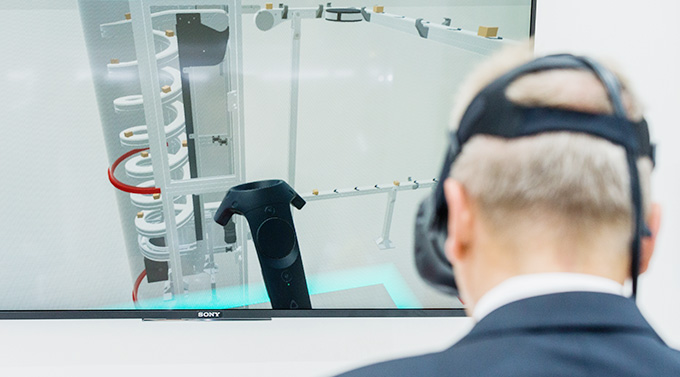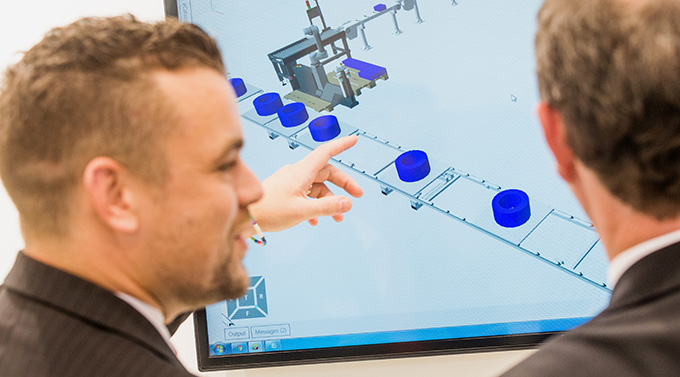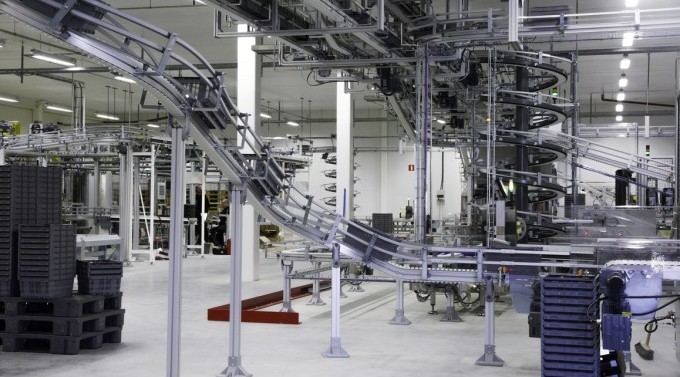
Imagine if you could see into the future and visualize how your new production line will operate. Or, if you could determine which optimization solution that will lead to the best production results before actually implementing them in real life. Simulation turns this dream into reality. Simulation helps to optimize both new and existing layouts as well as detect potential problems before they occur. In this blog article, I will describe simulation and how it can be used in the manufacturing industry.
Understand the impact of changes before they are implemented
Simulation is a way to understand the impact of changes before they are implemented in real life. That means, it is possible to get feedback on how a system behaves without having the real system in place. For a simulation to be accurate it is essential that the logic in the system is built according to a detailed specification that is defined by three different categories: system description, input data and scenarios.
Test future production volumes and new product mixes
 The system description defines the behavior of the system. It states how all processes interact with each other and under what conditions they run. The simulation model needs input data to know what to run. Input data can be, for example, order data, delivery schedule for raw material or cycle times. Input data and system description are together enough to build a simulation model representing the reality. However, the simulation model is often built to test future production volumes and new product mixes. Therefore, it is necessary to specify which scenarios the simulation model will be used for. If you, for example, know that a future production plan will put higher demands on the packaging machines it is wise to build a model that is able to adjust the number of packaging machines.
The system description defines the behavior of the system. It states how all processes interact with each other and under what conditions they run. The simulation model needs input data to know what to run. Input data can be, for example, order data, delivery schedule for raw material or cycle times. Input data and system description are together enough to build a simulation model representing the reality. However, the simulation model is often built to test future production volumes and new product mixes. Therefore, it is necessary to specify which scenarios the simulation model will be used for. If you, for example, know that a future production plan will put higher demands on the packaging machines it is wise to build a model that is able to adjust the number of packaging machines.
Optimize layouts in an innovative and cost-efficient way
 There are many advantages with using simulation. A simulation model helps optimize both new as well as existing layouts. Since it is possible to view a system before it is implemented, it is possible to detect potential problems with the system. Thus, it comes with a financial advantage since it costs less to fix errors in the computer than in reality. When looking into the future you can also, within minutes, simulate months of production. Another important outcome that is hard to measure is the improved communication between customer and supplier. With a simulation model in place, all parties can sit down and look at the production together. That makes it easier to both explain and understand how the system will work and behave after implementation.
There are many advantages with using simulation. A simulation model helps optimize both new as well as existing layouts. Since it is possible to view a system before it is implemented, it is possible to detect potential problems with the system. Thus, it comes with a financial advantage since it costs less to fix errors in the computer than in reality. When looking into the future you can also, within minutes, simulate months of production. Another important outcome that is hard to measure is the improved communication between customer and supplier. With a simulation model in place, all parties can sit down and look at the production together. That makes it easier to both explain and understand how the system will work and behave after implementation.
A simulation model brings the opportunity to test new and innovative ideas that might not have been tested in a real production line. A good example of a useful output when using simulation is the delivery performance, meaning how well your production can meet the needs of the market. The production might be able to deliver the total capacity seen over a year, but can it handle the variations?
Simulation as a part of your daily business
A challenge with simulation is knowing how and when to address simulation resources. Usually, projects are driven quite far before simulation is involved, which could have a negative impact on the solution. Simulation can contribute to important and cost-effective solutions to problems, as well as facilitate the handover process between customer and supplier. Therefore, it is important to involve simulation early on in a project. The simulation model should, as the real project, evolve to contain more and more details as the project progresses. By creating a process that makes simulation a part of the business instead of a separate activity, value can be added through all project steps.
Efficient simulation projects that answers your questions
FlexLink has a simulation team that performs simulation projects. By having a central team with simulation experts, we can ensure an efficient process that gives answers to your questions. By using simulation, we create an even better communication between us and our customers and help them fulfill their dreams and visions of optimized and smart production equipment.
Do you have any experience from simulation in the manufacturing industry? If you do, please share your experiences in the comments below. We would love to hear your thoughts! Would you like to know more about FlexLink and our automated production flow solutions? Visit our website, our smart factory blog or our social media channels.






Leave a Reply